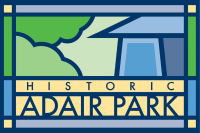When you walk the tree-lined streets of Adair Park, you’re stepping into a living story — a history written not only by architects and planners, but by everyday neighbors who dreamed, built, struggled, and thrived.
Today, Adair Park is one of Atlanta’s most beloved historic neighborhoods, known for its vibrant community, charming architecture, and creative spirit. But to fully appreciate where we are now, we have to understand where we came from.
The Founding of Adair Park
Adair Park was named after Col. George Washington Adair, a slave dealer turned post-Civil War real estate developer who worked to expand Atlanta’s footprint following Reconstruction. In the 1890s, Adair and his sons purchased farmland southwest of downtown Atlanta, envisioning a “streetcar suburb” connected by newly emerging public transit lines.
Designed to attract middle-class families, Adair Park’s original development embraced the ideals of the Garden City movement: orderly layouts, green spaces, and modest but well-designed homes.
The first wave of construction brought the classic American Craftsman bungalows and Folk Victorian cottages that still define much of the neighborhood’s character. Easy access to the BeltLine’s predecessor railways made Adair Park a convenient and desirable place to live for workers in Atlanta’s growing industries.
A Neighborhood on the Rise
Throughout the early 20th century, Adair Park thrived. Families built porches where neighbors gathered, children played in the parks, and the tight-knit community celebrated life’s milestones together. Schools like the George W. Adair School (now Academy Lofts) became centers of local pride and education. Even that rehabilitation project located in a prominently African-American neighborhood stirred controversy based on Adair’s ties with the Ku Klux Klan has made some argue that the school should not reopen with the same name.
Architecturally, Adair Park flourished with a mix of Queen Anne, Colonial Revival, Tudor Revival, and American Craftsman homes. Commercial hubs like Murphy Avenue supported small businesses and contributed to a walkable, lively atmosphere.
The proximity to downtown Atlanta made Adair Park both connected and distinct: a neighborhood where you could feel the pulse of the city but still savor the quiet of tree-lined streets.
The Civil Rights Era and Change
As Atlanta’s Civil Rights Movement gained momentum in the 1950s and 60s, Adair Park—like much of the city—faced demographic and political changes.
The end of segregation opened new housing opportunities across the city, but also introduced pressures of white flight and disinvestment. In Adair Park, Black families began moving into the neighborhood in the 1960s and 70s, seeking better housing and community. While many residents welcomed integration, others left, and decades of systemic policies led to uneven investment.
Despite the challenges, a new generation of Adair Park residents continued to breathe life into the neighborhood, focusing on family, faith, and community resilience.
Revitalization and Preservation
By the late 20th century, Adair Park experienced periods of decline—abandoned properties, disrepair, and economic hardship were visible in some areas.
Yet neighbors never gave up. In the early 2000s, grassroots revitalization efforts picked up momentum. Residents formed Adair Park Today, the neighborhood’s 501(c)(3) organization, committed to historic preservation, safety, and community building.
The establishment of the BeltLine’s Westside Trail reinvigorated interest in the neighborhood. Suddenly, Adair Park’s proximity to transit, green space, and downtown became a major asset again.
Today, thanks to decades of activism, organizing, and careful stewardship, Adair Park is a model of how a historic neighborhood can honor its past while creating space for the future.
The Architecture We Protect
Walk through Adair Park and you’ll see:
- Craftsman Bungalows with wide front porches
- Folk Victorian homes with delicate spindlework
- Four-Square houses with solid, proud lines
- Commercial storefronts that tell stories of a bygone era
Adair Park is now listed as a protected Historic District, meaning any changes to the exterior of homes must meet specific preservation guidelines. This ensures that while the neighborhood evolves, its architectural soul remains intact.
Adair Park Today and Tomorrow
Today, Adair Park stands as a beacon of inclusivity, resilience, and vibrancy.
Families, artists, students, and elders coexist and collaborate. New developments like Abram’s Fixtures, The Met, Murphy Crossing, CreateATL provide creative spaces. Murals, public art, and gardens dot the landscape. Porches once again hum with conversation.
But we face new challenges: rising property values, pressures from outside developers, and the ongoing work of making sure Adair Park remains accessible and welcoming to all.
We are committed to protecting legacy residents while welcoming new neighbors. We are investing in public safety, green spaces, and cultural programming. We are standing up for better transit, better housing options, and thoughtful development.
Why the History Matters
Understanding Adair Park’s history isn’t just about knowing dates or names—it’s about understanding the living heartbeat of this place. Every porch beam, every garden bed, every mural carries the fingerprints of the people who fought to keep Adair Park vibrant.
Preserving that history while building a more connected, inclusive future is not someone else’s job—it’s ours.
How You Can Be Part of the Story
The future of Adair Park depends on neighbors and businesses standing together.
If you love this neighborhood’s beauty, resilience, and spirit, now is the time to get involved. Whether you volunteer, attend meetings, bake a pie, plant a tree, or advocate for safe streets—every action matters.

Together, we will honor our past and shape an even brighter future for Adair Park.


